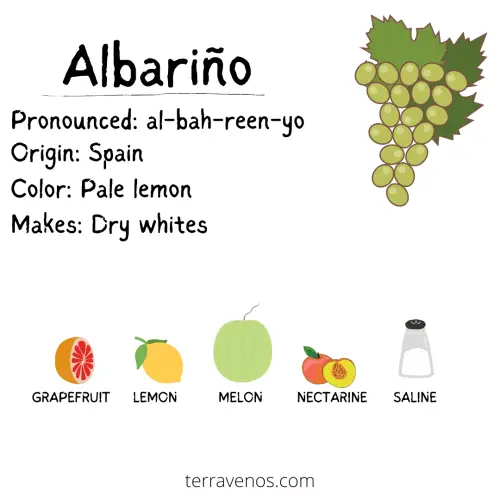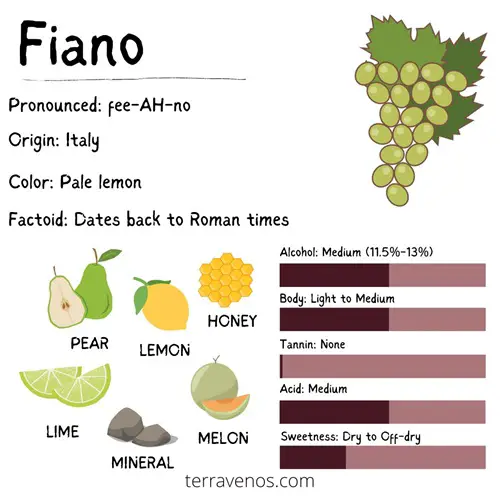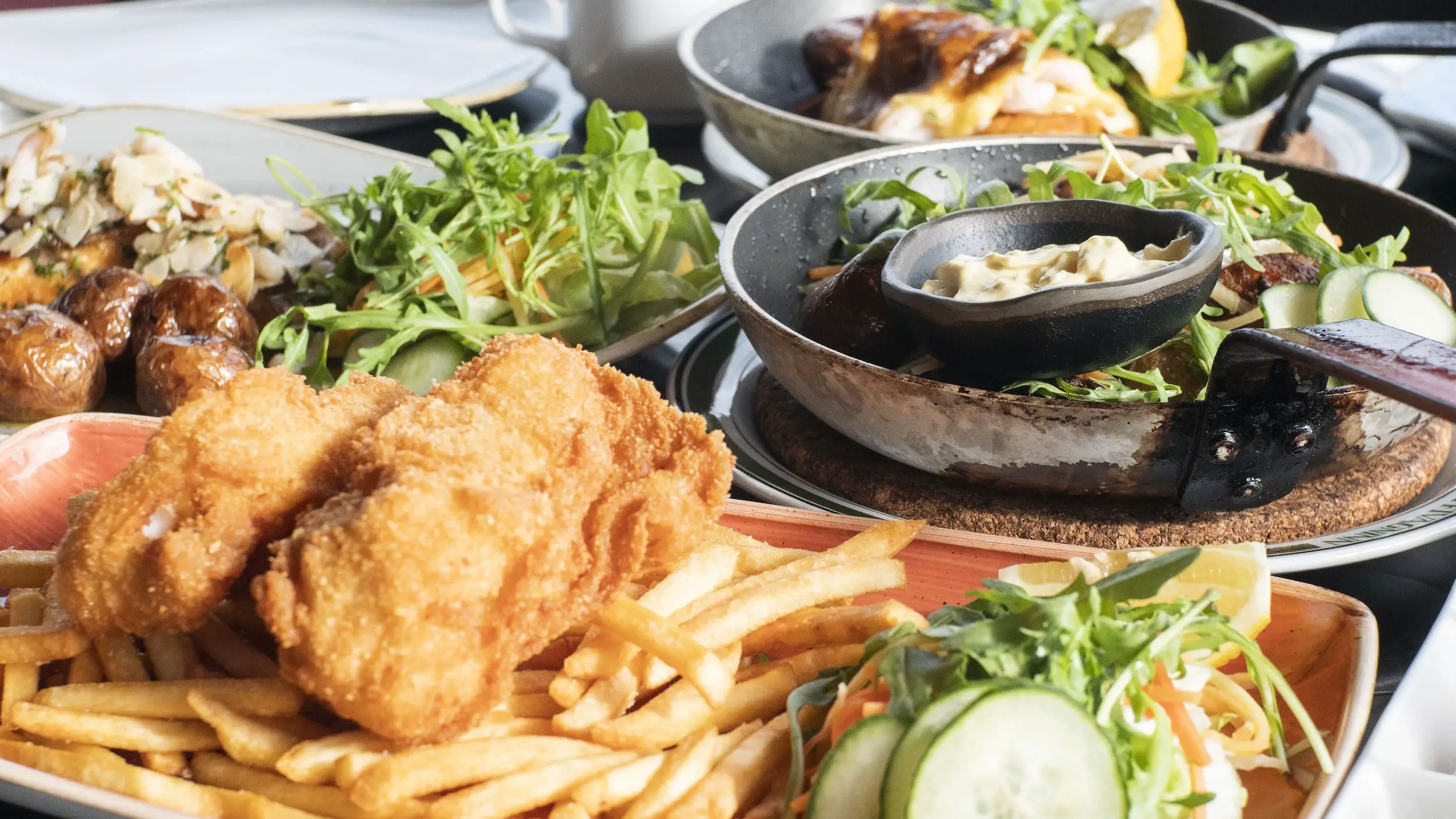| Characteristics | Fiano | Albariño |
|---|---|---|
| Hue | Pale lemon to gold | Pale to medium lemon |
| Color | White | White |
| Aromas | Citrus, melon, honey, mineral, pear | Citrus, stone fruit, saline |
| Sweetness | Dry to off-dry | Dry |
| Acid | Medium | High |
| Alcohol (%) | 12-13% | 11.5-13.5% |
| Body | Light to medium | Light to medium |
| Intensity | Medium | Medium |
| Key Growing Regions | Italy (Campania) | Spain (Rias Baixas), Portugal |
| Classic Pairings | Seafood, pasta, poultry | Seafood, Shellfish, salads |
| Price Range | $20-$50 | $15-$30 |
Fiano vs Albariño is a fantastic white wine comparison because these two have much in common.
Albariño has more acid than Fiano, with citrus and saline notes. Fiano has citrus, honey, and mineral notes. Both are medium alcohol and light to medium-bodied white wines. Both pair well with seafood, salads, and appetizers.
TL;DR: If you like Albariño, you’ll probably enjoy Fiano.
Here’s what you need to know about Fiano vs Albariño.
Albariño Basics: Spain’s Coastal Queen

Albariño, a gem from Spain’s Rías Baixas region in Galicia, captures the essence of its maritime terroir. This zesty white wine boasts a vibrant acidity that enlivens the palate. Albariño embodies refreshing citrusy notes, accompanied by hints of floral elegance.
Its crisp and invigorating profile makes it a perfect companion for seafood dishes. Think oysters, fish and chips, ceviche, and more.
In Rías Baixas, where Albariño reigns supreme, the wine reflects the region’s coastal charm. The combination of cool ocean breezes and mineral-rich soils imparts a unique character to the grapes, resulting in wines that embody the spirit of the Galician coastline. Helpful Tip: Go check out this post for a deep dive into Albariño wine.
Fun Wine Fact: The name “Albariño” is derived from the word “Alba,” which means white in Galician, reflecting the grape’s light color.
Fiano Basics: Italy’s Other White

Fiano’s a white Italian wine grape at home in the Campania region of Southern Italy. For much of time, producers made Fiano in an oxidative style. Today, improvements in winemaking science have turned this little grape into a delightful white wine showcasing citrus, Asian pear, melon, mineral, and honey notes.
Fiano will usually have a medium minus to medium body, and medium acid. It comes in dry and off-dry styles. Check out more on Fiano here.
Helpful Wine Buying Tip: Look for wines with the Fiano di Avellino DOCG designation for a classic Fiano experience.
Wine Comparison: Fiano vs Albariño
Here’s a quick overview of the most common styles of Fiano and Albariño wines.
Albariño Wine Profile
- Sweetness: Albariño wines tend to be dry, offering little to no residual sugar.
- Alcohol: Typically, Albariño wines have a moderate alcohol content, ranging from around 11% to 13% ABV, similar to Fiano.
- Body: Albariño wines generally have a medium body, providing weight to your palate.
- Acid: Albariño is renowned for its vibrant acidity, which adds freshness and liveliness to the wine. It will be higher than Fiano.
- Aroma and Intensity: Albariño boasts pronounced flavors and aromas, with a focus on citrus notes, especially lemon and lime.
- Flavors: In addition to citrus, Albariño often exhibits flavors of green apple, peach, apricot, and sometimes a hint of saline minerality.
Fiano Wine Profile
- Sweetness: Fiano wines lean towards dryness, but can be found in dry to off-dry styles.
- Alcohol: Fiano wines typically have a Medium alcohol content, similar to Albarino wines.
- Body: Fiano is known for its medium minus to medium body.
- Acid: Fiano has medium acidity, lower than Albarino.
- Flavor and Aroma Intensity: Fiano has citrus, melon, pear, mineral, and honey notes.
- Flavors: The flavor profile often includes lemon peel, lime, honeydew melon, pear, mineral, and even a slight spice with age.
Are Fiano and Albariño Similar?
Fiano and Albariño are similar. Both wines showcase citrus flavors, making them suitable for light dishes and pairing well with seafood. Both wines are made using protective winemaking techniques to preserve their fresh aromatics. This means using stainless steel and temperature-controlled fermentation. Both Fiano and Albariño have medium alcohol and a lighter to medium body.
What Is the Difference Between Fiano and Albariño?
Fiano is less acidic than most Albariño wines. While most Fiano wines are dry, they sometimes come in an off-dry style. Albariño are almost always dry. Fiano wines have a classic honey and mineral note that can turn spicy with age. Albariño wines have a touch of saltiness when grown near coastlines.
Albariño vs. Fiano: Food Pairings and Serving Temperature

Fiano will pair well with lighter cuisine. Lean into the wine’s citrus core when thinking about food pairing. Chicken, white fish, salads, creamy cheeses, and cream sauces will all pair well with Fiano.
Albariño’s zesty acidity and citrus notes make it a perfect match for coastal seafood dishes, shellfish, and light salads. The wines’ acid compliments these dishes and adds a refreshing touch, just as if you were adding a spritz of lemon.
Both wines are best enjoyed chilled.
Place them in the refrigerator overnight or for a few hours before serving. For Fiano, remove the bottle from the refrigerator approximately 10-15 minutes before pouring to reach the ideal serving temperature. Albariño can be enjoyed immediately after opening.
Helpful Tip: If you’re just getting started with wine, head over to the post that covers just the basics of food and wine pairing.
Which Is More Expensive: Fiano vs Albariño
Wondering about bottle costs when comparing Fiano and Albariño? Albariño enjoys greater popularity overall and is more widely planted in many regions around the world, so the least expensive bottles cost less than Fiano.
| Quality Level | Albariño | Fiano |
|---|---|---|
| Entry-level | $10 – $20 | $20 – $30 |
| Premium | $25 – $50+ | $30 – $50 |
How Much Does Albariño Cost?
- Entry-level Albariño wines also come at accessible prices, usually falling within the $10 USD range per bottle. These wines are known for their vibrant acidity and refreshing characteristics, making them versatile for casual sipping or food pairing.
- On the premium side, Albariño reveals its elegance and expressive flavors. Premium Albariño wines, sourced from renowned regions, can be priced from $25 to $50 or even higher, delivering a memorable drinking experience.
Exploring different price points within each varietal allows you to find a Fiano or Albariño wine that aligns with your taste preferences and budget.
Helpful Tip: Albariño wines are definitely bottles you’ll find at your local grocery store. Check out this post for 9 quick tips on how to buy great grocery store wines.
Fiano Cost
- Entry-level Fiano wines are more expensive on the export market than other Italian whites. Expect to pay $20-$30.
- On the premium side, Fiano will have more intense honey and layered mineral notes. They may even have the ability to age. Premium Fiano wines will cost $30 to $50, but rarely more than that.
Which Is Better? Fiano vs Albariño
If you want a high-acid, linear white wine, then Albariño is better. If you enjoy softer citrus, honey, minerality, and higher alcohol, Fiano is better. If you are on a wine budget, then Albariño is less expensive than Fiano.
Final Thoughts – Fiano vs Albariño
Fiano and Albariño are both refreshing white wines, but unique in their own right. Fiano is citrusy and has layered honey and mineral notes. Albariño has that citrus and saline core.
Your Challenge: Get a similarly priced bottle of Fiano and Albariño and host a DIY tasting this weekend.
Thirsty for More?
Discover More:
Pinot Grigio vs Vermentino
Viognier vs Riesling
Sauvignon Blanc vs Pinot Grigio
Pinot Grigio vs Pinot Blanc



